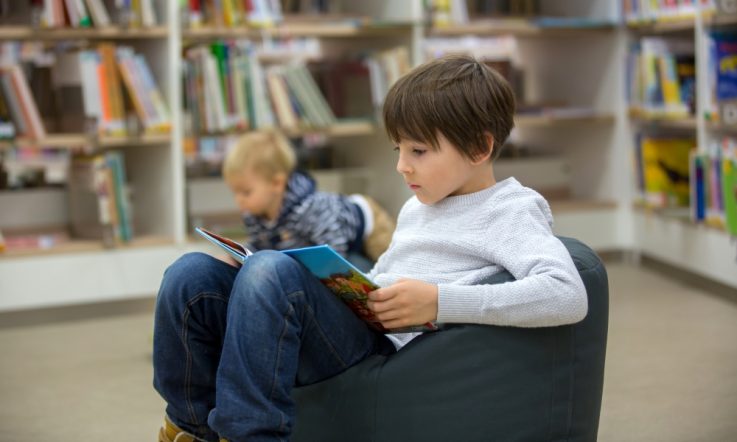Last year, Vanessa Collins, Curriculum Director at Queenwood School for Girls’ Junior School, an independent school on Sydney’s Lower North Shore, shared details with Teacher of an action research project, ‘Just Read’, which the school took on at the beginning of 2020 in order to build a school reading culture.
Despite the challenges posed by COVID-19, the 12-month research project concluded successfully and analysis of its impact has shown wide-ranging improvements for student outcomes and wellbeing. The program has also had a positive impact on staff. In this article, we check in with Vanessa to find out more.
Queenwood School for Girls’ ‘Just Read’ program was implemented in both the Junior and Senior Schools and involved allocating space in the timetable for students in Kindergarten to Year 11 to read on a daily basis. The program also ensured time for students to discuss books and had teachers model reading for pleasure.
Improving student vocabulary development
Part of the research project involved the collection of data from all teachers and students in Years 4 to 10 to assess the impact of the program. One area the school was looking to improve during the research project’s duration was literacy skills – specifically, vocabulary development and reading comprehension.
‘Over the 12 months of the project, we found that vocabulary improved on average for all students in all grades … bar one,’ Vanessa Collins tells Teacher.
‘Interestingly, the greatest improvements were for students in the lower-performing quartiles. So those kids who struggle with vocab showed the most gains during our testing and data collection on vocabulary development. The improvements in vocabulary were also greater in the Junior School than the Senior School,’ she shares.
The data on reading comprehension was much more varied. ‘We had improvement in some year groups but not in others,’ Collins says. ‘Obviously, this data is COVID-affected and we kind of expected, I suppose, with reading comprehension, and only a 12-month data capture, that we might not get a really strong result there … so we saw some gains.’
Elements of a successful silent reading program
Collins says their research project highlighted 2 key features of a successful sustained silent reading program. The first is consistency (in this case, ensuring reading for pleasure occurs daily), and the second relates to the types of books the students are reading. For their school, students reading hard copy fiction texts they selected themselves was important.
‘The self-selection was crucial, because part of our project was about strengthening students’ ability to self-select appropriate texts. … And I think along with that, building time in for students to discuss the books they were reading was also a highly recommended practice,’ Collins says.
In the Junior School, this involved students participating in ‘chat circles’ at least twice a week. Students would also be given time to give a quick, 30-second speech to their peers on the book they’re reading and why they like it.
Students in the Senior School developed a website which was designed to extend student reading choices. This also allowed students to discuss the broader issues explored in texts they were reading and to connect with others that share similar interests.
These initiatives came about through the formation of student advisory committees, which students volunteered to be a part of. ‘Those student-led committees were also instrumental in providing our committee (who are running the project) with insight into the student experience of the project,’ Collins shares.
‘They would come back and talk to us about how kids were feeling about the project; what they're enjoying, what they're observing. And that was instrumental to us tweaking elements of the project.’
The importance of teacher modelling
Part of the Just Read program involves staff participating in reading for pleasure alongside their students.
‘I would strongly recommend that teacher modelling should occur in any silent reading model. You just wouldn't believe how observant those students are about the adults and what they're doing,’ Collins says. ‘The role modelling aspect definitely led to a building of common ground between the teachers and students. And in all the classrooms, I think that only serves to enhance the classroom experience around literature for all of them.’
Collins adds that students have demonstrated interest in the books their teachers are reading and have even shown interest in reading their teacher’s favourite childhood texts, which has seen students reaching for more classic books.
‘Staff also have commented that they've had an increased number of conversations with their colleagues about books they’re reading. One teacher said to me that their relationships have been enhanced by discovering shared passion for thrillers or sci-fi with other colleagues.’
A lasting impact on wellbeing
In Vanessa’s 2021 article, she shared that participating in Just Read during remote learning had a positive impact on student wellbeing and afforded them a sense of calm during such an uncertain period. One year later, with the program still in place post-lockdown, the impacts on wellbeing are still evident.
‘In our surveys … (which were conducted post-lockdown) many staff continued to mention the wellbeing of students being positively affected by that program. Teachers primarily continued to describe supporting students by helping them to switch off, calm down and refocus. In fact some teachers said the wellbeing effects were just as great, if not greater than the literacy effects.
‘If anything, now that we're back into the full swing of school operations with all the busyness of full school days, these wellbeing benefits are being noticed even more by staff, by parents and by students themselves. Students often talk about Just Read being a time to forget about everything, get lost in a book, and Senior School students have made specific links between Just Read and a decrease in their stress levels,’ Collins says.
In staff surveys, teachers also shared they have observed an increase in students’ preparedness to learn. Some commented that the program settled students and created an environment where they were more ready to engage with the curriculum, and others said the period following Just Read was their favourite teaching time, because students were ready to learn.
While the research project has concluded, the overwhelmingly positive impact of Just Read means it will continue to be a core part of the timetable at Queenwood School for Girls.
How would you describe the culture of reading at your school? Is there room for improvement?
As a school leader, do you model reading for pleasure? Do you encourage staff to read for pleasure? In what ways could you inspire staff and students to read for pleasure on a regular basis, and discuss the books they are reading?



